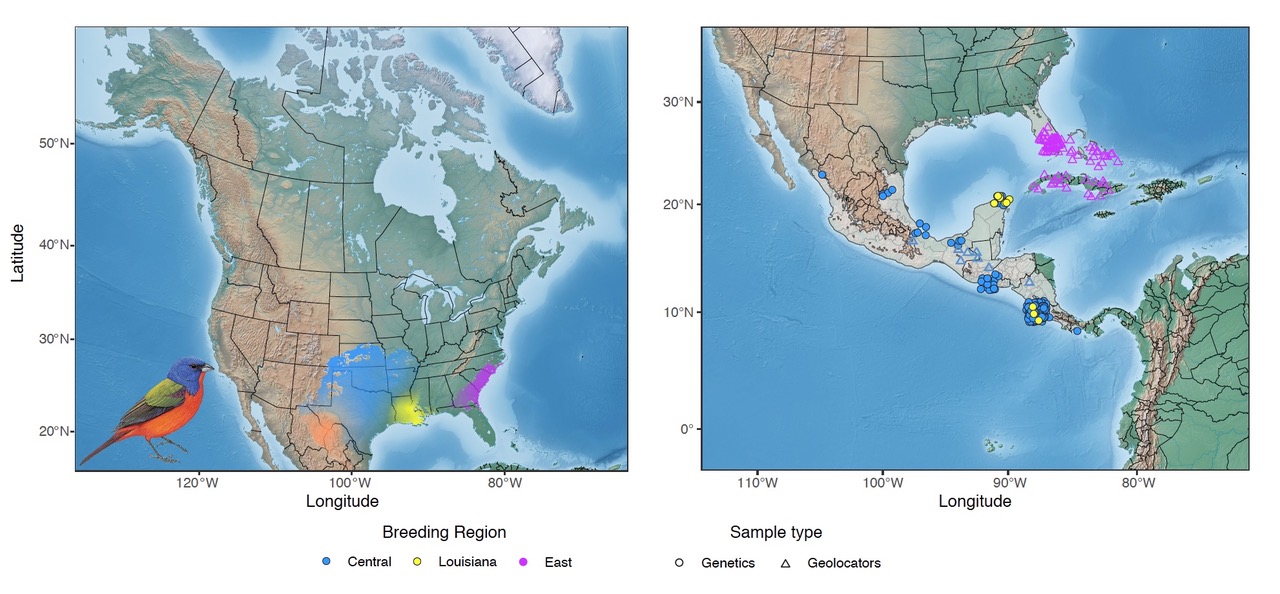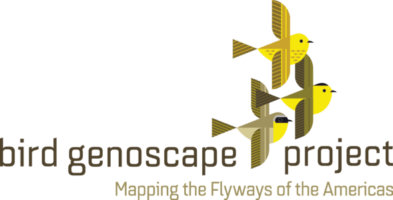Painted Bunting

The four genetically distinct populations of Painted Bunting (Passerina ciris) (left map) across the breeding range: southern Texas and Mexico (orange), Central (blue), Louisiana (yellow), and East (purple). Individuals sampled on the wintering grounds (right map) were then assigned back to three of these genetic clusters, allowing us to better understand the migratory connectivity of Painted Bunting populations. Genetic clusters are visualized as transparency levels of different colors overlaid upon a base map from Natural Earth (naturalearthdata.com) and clipped to the species breeding range using an eBird shapefile. See below for details of samples used. Painted Bunting Image by © Birds of the World
The Painted Bunting (Passerina ciris) is an iconic North American migratory songbird. Two nominate subspecies have been described, with the smaller and more restricted eastern subspecies of potential conservation concern. Over the past ten years, researchers have developed several Painted Bunting studies to track their movements via geolocators, niche modeling, agent-based modeling, detection of stable-isotope signatures in feathers, and international pet-trade investigations. The genetic aspect of research on the Painted Bunting has been facilitated by a collaboration between the Oklahoma Biological Survey (OU), the Center for Tropical Research (UCLA), and the Bird Genoscape Project. Since 2009, our team has worked together to understand the population genomic structure across the Painted Bunting’s breeding range and the migratory connectivity of these populations using genomic tools. Together we’ve screened the Painted Bunting genome and developed a genoscape and full network model of their annual movements. Click here to learn more about Andrea Contina and the OU-based research on Painted Buntings.
The Bird Genoscape partnered with numerous collaborators to develop high-resolution molecular markers to identify breeding populations of Painted Buntings in North America. We scanned the genomes of 131 individuals from 26 sampling locations across the Painted Bunting breeding range in the United States to identify population structure. In total, we’ve identified the existence of 4 genetically distinct populations of Painted Buntings – Central (blue), Louisiana (yellow), Texas and Mexico (orange), and East Coast (purple). These 4 populations can serve as the foundation for Painted Bunting conservation and management.
Our work is ongoing with the Painted Bunting, as we continue to collect additional samples across the wintering grounds to hopefully be able to discern where the southern Texas and Mexico (orange) breeding population spend the winter.
Bird Migration Explorer: Click here to see how Audubon’s Bird Migration Explorer has incorporated our Painted Bunting genoscape into their base map.
Publications:
Contina A, Bossu CM, Allen D, Wunder MB, & KC Ruegg. 2023. Genetic and ecological drivers of molt in a migratory bird. Scientific Reports 13: 814.
Rueda-Hernandez R, Bossu CM, Smith TB, Contina A, Canales del Castillo Ricardo, Ruegg K, & BE Hernandez-Banos. 2023. Winter connectivity and leapfrog migration in a migratory passerine. Ecology and Evolution 13: e9769.
Contina A, Bay RA, Underwood VL, Smith T, Kelly J, Bridge E, and K Ruegg. 2019. Characterization of SNP markers for the Painted Bunting (Passerina ciris) and their relevance in population differentiation and genome evolution studies. Conservation Genetics Resources: 11: 5-10.
Contina A, Alcantara JL, Bridge E, Ross JD, Oakley WF, Kelly J, KC Ruegg. 2019. Genetic structure of the Painted Bunting and its implications for conservation of migratory populations. IBIS: 161: 372-386.
Access to Sequencing Data:
Team:
Thomas B. Smith, UCLA
E. Bridge
T. Michels
W. Oakley
H. LePage
E. Besozzi
J. Muller
J. Johnson
M. Poole
Utilized Painted Bunting Samples
Explore the map below to see when, where, and who collected the samples to build this genoscape.
